Another go in the waters of San Diego
As the weather got warmer in San Diego, my body's memory of the cold water at Coronado Islands faded. The temperature during the day hovered at 20° C, dropping to 15° C in the night. 20° C seemed like a comfortable number, and if it dropped by 2 underwater, it still seemed manageable to me, so I called Blue Escape (http://www.blueescape.com) on Thursday (10 April) to book a place. I wanted to try a spot of wreck diving, so I booked a seat on the boat that was scheduled to do 2 dives on the HMCS Yukon wreck and 1 on the Ruby E wreck. Then I thought I'd check the weather forecast on Yahoo, it was not good. The temperature would go down as the week progresses and it would be cloudy on Saturday with rain coming in the following week. It was a good thing I booked before I checked the weather forecast, it was too late to back down.
Saturday morning, I bravely got up early to catch #34 bus to go to Mission Bay. Mentally I was completely prepared to be frozen again. When I reached the dive shop at 6.55 a.m., it was already opened and a bunch of divers were milling around the cash register to pay for the trip. They were a group of 7 divers from Ventura, a place 2-hour-drive north of San Diego. They had arrived early, thinking that the boat would be leaving at 7 a.m.; however, I was told that the boat would leave at 8 a.m. I saw Sean, the boatman for Blue Explorer, and he remembered my name, he immediately wrote it on the manifest he was preparing.
I waited patiently for the last guy to finish checking the oxygen content of the 6 nitrox tanks he was getting from the shop. Then I signed the release form, paid for the trip and the rental and got my kit (US$110.00). I helped myself in their storeroom in getting the wetsuit, hood, BC and regulator. I asked and got the info that the Yukon wreck is only about 15 minutes out of Mission Bay, so I put on the farmer john wetsuit, bundled all the rest of the gear together, and walked to the boat.
The other divers were already on the boat, then somebody discovered she had left her regulator back at the hotel nearby. So her partner had to drive back to the hotel to retrieve it. Finally we left the dock at 8 a.m. I introduced myself to the divemaster, Pierre, and to the leader of the other divers. I informed Pierre that I did not have any experience diving in large wrecks, and indicated that I did not want to do any penetration dive. And so I was grouped together with Tim and Sarah, a young husband-wife team, who had never dived at the Yukon wreck, and would probably not do any penetration of the wreck. Tim happened to be the guy who was checking the nitrox tanks earlier on. I tried to recall the guidelines for diving on normal air with people diving on nitrox, but I could think of nothing except that they would probably get to enjoy a longer bottom time in the 2nd and 3rd dive. The three of us would be using single tanks (other divers had brought along twin tanks sets). They looked young and fit, and I could see that they were going to dive in drysuits (in fact everyone in that group was diving with drysuits). By all counts, the only problem that would arise is when my air became low before theirs did, which is a great possibility since their youth and fitness would allow them to breathe more effectively than I do. Furthermore, they would be warm in their drysuits, so they would be expending less effort underwater, and logically would use less air. My second concern was "Do I know how to vent the air from their suits if the need arises?". I just had to remember to do things slowly and think out everything calmly if it came to that.
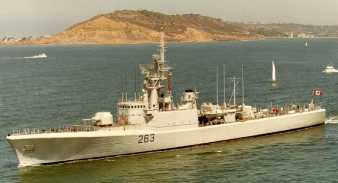 In a very short while, we arrived at the wreck. There were already 2 other dive boats atop the wreck; there were also a couple of dinghies, with solo divers, preparing to dive the wreck! The Yukon was intentionally sunk for the purpose of diving, and a number of buoys were secured to the different parts of the wreck. Pierre had wanted to anchor to the buoy secured to the wheelhouse of the wreck, but that one was already occupied. So we had to tie the boat to the buoy secured to the stern of the wreck.
In a very short while, we arrived at the wreck. There were already 2 other dive boats atop the wreck; there were also a couple of dinghies, with solo divers, preparing to dive the wreck! The Yukon was intentionally sunk for the purpose of diving, and a number of buoys were secured to the different parts of the wreck. Pierre had wanted to anchor to the buoy secured to the wheelhouse of the wreck, but that one was already occupied. So we had to tie the boat to the buoy secured to the stern of the wreck.
After Pierre's briefing, I asked Tim what he intended to do. He replied that he would explore from the stern to the wheelhouse. So that was the briefing, with the understanding that he would lead the dive. I didn't exactly know what their qualifications were, but they looked pretty proficient with their equipment, as were the others on the team. Tim's kit was even equipped with two pony tanks, one was yellow, that would be normal air, the other was white, with "ARGON" printed on it. I've never heard of argon* being used in diving, I only knew that it is an inert gas that is heavier than helium. I supposed it is used for his drysuit. I didn't ask about it because by the time I noticed it, he was jumping out of the boat into the water. Then Sarah jumped, and I followed. Sarah's equipment looked ordinary except for her new and nice-looking Abyss Diving System drysuit. Since they were using nitrox, their dive computers must be quite sophisticated. These must be rich people.
We descended via the buoy line, and reached the wreck at 20 metres. The bottom was supposed to be about 33 metres deep, and the ship 13 metres wide, and it was lying on its port side. Visibility was not very good, about 3 metres near the surface, then it increased to about 8 metres on the wreck. The first thing I did on reaching the wreck was to look at the temperature reading of my dive computer: 12° C! It was colder than my last trip out! But I felt OK, the wetsuit was doing its job, and I followed Tim and Sarah. Tim was heading in the direction of the bow, to go to the wheelhouse.
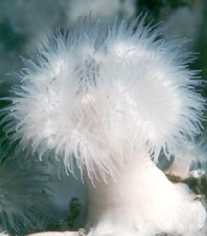 The wreck was lying in a north-south direction. All along the hull of the ship, rectangular holes have been cut to make the inside accessible to divers, each of these holes can comfortably accommodate the passage for one diver. Pierre had warned the divers to be careful and not to snag any part of their nice drysuits onto the wreck. I could see that the ship was painted white as it had not been completely encrusted, in fact, it was quite "clean". The main creatures that were colonising it were lots of white ghostly anemones (metridium senile), which went well with the white hull.
The wreck was lying in a north-south direction. All along the hull of the ship, rectangular holes have been cut to make the inside accessible to divers, each of these holes can comfortably accommodate the passage for one diver. Pierre had warned the divers to be careful and not to snag any part of their nice drysuits onto the wreck. I could see that the ship was painted white as it had not been completely encrusted, in fact, it was quite "clean". The main creatures that were colonising it were lots of white ghostly anemones (metridium senile), which went well with the white hull.
Eventually, we reached the wheelhouse, and instead of exploring the wheelhouse in detail as I expected, Tim and Sarah turned around and finned back to the stern. And when we reached the stern, Tim led the ascent. I didn't see him signal to me, but he and Sarah just went up the buoy line, so I followed. I looked at my content gauge, I still had 1200 p.s.i. of air! I supposed all Tim had in mind was Sarah, so I was actually diving solo - I had become an underwater lamp-post.
At the surface, after dekitting, Sarah asked me how much air I had left. Well, after the 3-minute stop at the 6-metre depth, where Sarah finally gave me an OK sign, I had 1100 p.s.i. left. I asked about her, and she said 800. So it turned out that I am not the heaviest breather in the group. I believed she seldom dive and that she was quite excited about it, but I was not sure, because I was always a few metres behind them, and didn't get any eye contact with them underwater.
Sean came with hot coffee for all of us. I drank my coffee, chewed a slice of honey dew melon, and immediately changed tank for the next dive, which would be at the same wreck. Meanwhile Tim was doing the same thing, while Sarah disappeared, I presumed to ease herself. Soon, the other guys started surfacing, with Sean and Pierre helping out with their exit. Pierre had earlier suggested doffing their twin tanks in water so that they would not need to climb up the boat with all the load. I could see Pierre and Sean heaving at their tasks because besides the twin tanks, the weights are also integrated into the BC.
When everybody was up, Sean asked the group if they would like to do kelp diving later on. There was a short discussion, and all the while, Tim had kitted up for the next dive, he was keen to explore the other half of the wreck. Then the decision was made to do a second dive at the same wreck and a third one at the kelp bed off Point Loma.
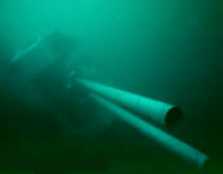 I did a fast kitting so as not to delay the second dive, but Sarah was not ready. So Tim and I had to wait for her, and Tim wasn't too happy about it. Eventually we entered water, and swam over to the buoy that Pierre had indicated as the one secured to the bow of the wreck. As we descended along the buoy line, I began to feel the cold. On reaching the bottom I looked at the computer - 13° C, well that was an improvement. Tim shot straight over the deck to examine it. I finned around the bow then to the deck, and came face to face with the gun barrels of the ship. Then Tim disappeared from view, he had penetrated into a hole on the deck, and surfaced 30 seconds later from a hole in the hull. And we finned around the wreck. A short while later, Sarah was conferring with Tim about her gauges. I didn't know what went on, but we were heading to the buoy line at the stern. No signal again, but I followed them to the 6-metre stop. Three minutes at 6 metres, and I saw the first surface signal from Tim! OK, we surfaced.
I did a fast kitting so as not to delay the second dive, but Sarah was not ready. So Tim and I had to wait for her, and Tim wasn't too happy about it. Eventually we entered water, and swam over to the buoy that Pierre had indicated as the one secured to the bow of the wreck. As we descended along the buoy line, I began to feel the cold. On reaching the bottom I looked at the computer - 13° C, well that was an improvement. Tim shot straight over the deck to examine it. I finned around the bow then to the deck, and came face to face with the gun barrels of the ship. Then Tim disappeared from view, he had penetrated into a hole on the deck, and surfaced 30 seconds later from a hole in the hull. And we finned around the wreck. A short while later, Sarah was conferring with Tim about her gauges. I didn't know what went on, but we were heading to the buoy line at the stern. No signal again, but I followed them to the 6-metre stop. Three minutes at 6 metres, and I saw the first surface signal from Tim! OK, we surfaced.
On the boat, I asked Tim what happened. He told me both their computers were flashing. He said that the computers had reset themselves to normal air when they changed tank. I didn't look at their gear, so I wasn't too sure if that was what happened, because we were only underwater for a total of 51 minutes for the 2 dives. It seemed that they don't know their computers well; for me, it was another note of caution on my part.
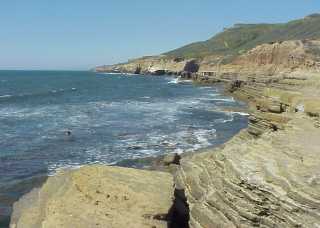 Lunch came. As was before, there was corn soup, and sandwich. I didn't eat any of those, because I didn't want to become sick and miss the third dive. So I drank some hot coffee and ate only 2 slices of melon. I was feeling a bit cold just after exiting from my second dive, but I thought I felt OK after some rest and a small bottle of water.
Lunch came. As was before, there was corn soup, and sandwich. I didn't eat any of those, because I didn't want to become sick and miss the third dive. So I drank some hot coffee and ate only 2 slices of melon. I was feeling a bit cold just after exiting from my second dive, but I thought I felt OK after some rest and a small bottle of water.
An hour later, we were on top of the kelp bed at Point Loma. Everybody was keen to go down. And it seemed like we were going to go down in a big group. According to Pierre, the kelp are giant seaweed, and they would grow up from the bed, rising vertically to the surface, they don't stop growing so the remaining growth float at the water surface. The floating kelp fronds would impede any attempt to swim on the surface, so for our dives, it would be best if we could surface via the anchor line. He explained that if we surfaced away from the boat and had to swim to it, we had to either swim below the floating kelp or sort of crawl over them. Number one precaution was not to get entangled with the kelp. I didn't bring any knife with me, so I had to be very aware of that.
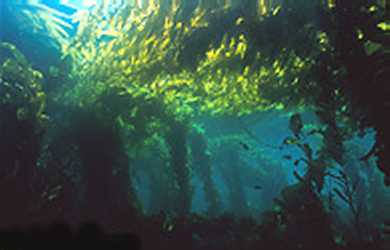 Everybody jumped off the boat, and then the whole group descended at the same time. We didn't descend via the anchor line, so I was quite sure I wouldn't be ascending by it. I had seen many nice photos of underwater scenery of kelp beds. They looked so hauntingly beautiful, so I was very pleased to be doing that dive. Well, those photos I saw must have been selected from a large number of kelp photos. The visibility near surface was quite bad, about 2 metres. At the bottom, which was about 17 metres, the visibility cleared up to about 4 metres. Very soon, the big group split into two underwater, one group of twin tanks and another of single tanks. I was lagging behind all of them. I found that I was finning slowly, which suited me since I wanted to have a good look at the surroundings, and that I wasn't moving my body much, only my legs for finning. I was moving my arms very minimally, most of the time to pick up shells to look at them. My computer was indicating 15° C, but it was my third dive, and the cold was starting to get to me. If I were to shrug my body, the small air-pockets under my suit would shift, the cold water would occupy the former position of the air-pockets, making parts of my skin to go from warm to cold. It was uncomfortable so I didn't move my body much.
Everybody jumped off the boat, and then the whole group descended at the same time. We didn't descend via the anchor line, so I was quite sure I wouldn't be ascending by it. I had seen many nice photos of underwater scenery of kelp beds. They looked so hauntingly beautiful, so I was very pleased to be doing that dive. Well, those photos I saw must have been selected from a large number of kelp photos. The visibility near surface was quite bad, about 2 metres. At the bottom, which was about 17 metres, the visibility cleared up to about 4 metres. Very soon, the big group split into two underwater, one group of twin tanks and another of single tanks. I was lagging behind all of them. I found that I was finning slowly, which suited me since I wanted to have a good look at the surroundings, and that I wasn't moving my body much, only my legs for finning. I was moving my arms very minimally, most of the time to pick up shells to look at them. My computer was indicating 15° C, but it was my third dive, and the cold was starting to get to me. If I were to shrug my body, the small air-pockets under my suit would shift, the cold water would occupy the former position of the air-pockets, making parts of my skin to go from warm to cold. It was uncomfortable so I didn't move my body much.
I started looking around me. The bottom was flat, and the fibrous roots of the kelp, which looked like roots of the coconut trees, looked like they were just stuck to rocky flat bottom. They were regularly spaced about one metre apart, so we could finned among them like gliding through a forest. I didn't see any sizeable fish at the bottom. I only saw starfish, sea urchins, sea cucumbers and a variety of molluscs, mostly small horse whelks and big top shells. There were signs of cowries but I didn't spot any live ones. I spotted 2 lobsters hiding in separate cracks along the flat bottom.
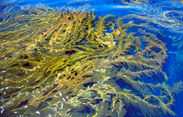 After about 15 minutes wandering at the bottom, my group made a U-turn and I knew we were heading back. At some point the 4 people in front of me started to ascend. I didn't follow straight away. I dumped all the air in my BC then finned up slowly. At various depths, I tried grabbing the kelp to see if I could hang on to them. I saw that the others were doing the same thing for their 6-metre stops. I didn't do the 6-metre stop, I did a very gentle ascent, sliding my way along the kelp. When we finally surfaced, we were still about 50 metres from the boat, and there was a large patch of kelp between us and the boat. Tim led Sarah back underwater to go to the boat. I made my way to the boat slowly through the gaps in the floating kelp. I had to crawl over some kelp branches, as Pierre had suggested, a few times. Actually, I just used my arms to sweep them under me while I finned gently forward. In the end, I got to the boat before the others did.
After about 15 minutes wandering at the bottom, my group made a U-turn and I knew we were heading back. At some point the 4 people in front of me started to ascend. I didn't follow straight away. I dumped all the air in my BC then finned up slowly. At various depths, I tried grabbing the kelp to see if I could hang on to them. I saw that the others were doing the same thing for their 6-metre stops. I didn't do the 6-metre stop, I did a very gentle ascent, sliding my way along the kelp. When we finally surfaced, we were still about 50 metres from the boat, and there was a large patch of kelp between us and the boat. Tim led Sarah back underwater to go to the boat. I made my way to the boat slowly through the gaps in the floating kelp. I had to crawl over some kelp branches, as Pierre had suggested, a few times. Actually, I just used my arms to sweep them under me while I finned gently forward. In the end, I got to the boat before the others did.
Aboard, I felt good. I had finished all the 3 dives, and I was none the worse, in terms of being cold, for them. I quickly dekitted and descended to the cabin and changed out of the wetsuit into dry clothing. The sun was shining brightly, contrary to the weather report, and I was pleased. I warmed myself in the sun, as Sean piloted the boat back to Mission Bay.
Tan Tsu Soo
La Jolla, 12 April 2003
* Argon gas is used in certain dry suit systems. It is a denser gas that provides better insulation than normal air; it retains more of the body heat and helps keep the diver warm longer. A separate inflation regulator/valve and cylinder system is used for the argon gas.

 Go to Dive Club 854 home page.
Go to Dive Club 854 home page.
 In a very short while, we arrived at the wreck. There were already 2 other dive boats atop the wreck; there were also a couple of dinghies, with solo divers, preparing to dive the wreck! The Yukon was intentionally sunk for the purpose of diving, and a number of buoys were secured to the different parts of the wreck. Pierre had wanted to anchor to the buoy secured to the wheelhouse of the wreck, but that one was already occupied. So we had to tie the boat to the buoy secured to the stern of the wreck.
In a very short while, we arrived at the wreck. There were already 2 other dive boats atop the wreck; there were also a couple of dinghies, with solo divers, preparing to dive the wreck! The Yukon was intentionally sunk for the purpose of diving, and a number of buoys were secured to the different parts of the wreck. Pierre had wanted to anchor to the buoy secured to the wheelhouse of the wreck, but that one was already occupied. So we had to tie the boat to the buoy secured to the stern of the wreck.
 The wreck was lying in a north-south direction. All along the hull of the ship, rectangular holes have been cut to make the inside accessible to divers, each of these holes can comfortably accommodate the passage for one diver. Pierre had warned the divers to be careful and not to snag any part of their nice drysuits onto the wreck. I could see that the ship was painted white as it had not been completely encrusted, in fact, it was quite "clean". The main creatures that were colonising it were lots of white ghostly anemones (metridium senile), which went well with the white hull.
The wreck was lying in a north-south direction. All along the hull of the ship, rectangular holes have been cut to make the inside accessible to divers, each of these holes can comfortably accommodate the passage for one diver. Pierre had warned the divers to be careful and not to snag any part of their nice drysuits onto the wreck. I could see that the ship was painted white as it had not been completely encrusted, in fact, it was quite "clean". The main creatures that were colonising it were lots of white ghostly anemones (metridium senile), which went well with the white hull.
 I did a fast kitting so as not to delay the second dive, but Sarah was not ready. So Tim and I had to wait for her, and Tim wasn't too happy about it. Eventually we entered water, and swam over to the buoy that Pierre had indicated as the one secured to the bow of the wreck. As we descended along the buoy line, I began to feel the cold. On reaching the bottom I looked at the computer - 13° C, well that was an improvement. Tim shot straight over the deck to examine it. I finned around the bow then to the deck, and came face to face with the gun barrels of the ship. Then Tim disappeared from view, he had penetrated into a hole on the deck, and surfaced 30 seconds later from a hole in the hull. And we finned around the wreck. A short while later, Sarah was conferring with Tim about her gauges. I didn't know what went on, but we were heading to the buoy line at the stern. No signal again, but I followed them to the 6-metre stop. Three minutes at 6 metres, and I saw the first surface signal from Tim! OK, we surfaced.
I did a fast kitting so as not to delay the second dive, but Sarah was not ready. So Tim and I had to wait for her, and Tim wasn't too happy about it. Eventually we entered water, and swam over to the buoy that Pierre had indicated as the one secured to the bow of the wreck. As we descended along the buoy line, I began to feel the cold. On reaching the bottom I looked at the computer - 13° C, well that was an improvement. Tim shot straight over the deck to examine it. I finned around the bow then to the deck, and came face to face with the gun barrels of the ship. Then Tim disappeared from view, he had penetrated into a hole on the deck, and surfaced 30 seconds later from a hole in the hull. And we finned around the wreck. A short while later, Sarah was conferring with Tim about her gauges. I didn't know what went on, but we were heading to the buoy line at the stern. No signal again, but I followed them to the 6-metre stop. Three minutes at 6 metres, and I saw the first surface signal from Tim! OK, we surfaced.
 Lunch came. As was before, there was corn soup, and sandwich. I didn't eat any of those, because I didn't want to become sick and miss the third dive. So I drank some hot coffee and ate only 2 slices of melon. I was feeling a bit cold just after exiting from my second dive, but I thought I felt OK after some rest and a small bottle of water.
Lunch came. As was before, there was corn soup, and sandwich. I didn't eat any of those, because I didn't want to become sick and miss the third dive. So I drank some hot coffee and ate only 2 slices of melon. I was feeling a bit cold just after exiting from my second dive, but I thought I felt OK after some rest and a small bottle of water.
 Everybody jumped off the boat, and then the whole group descended at the same time. We didn't descend via the anchor line, so I was quite sure I wouldn't be ascending by it. I had seen many nice photos of underwater scenery of kelp beds. They looked so hauntingly beautiful, so I was very pleased to be doing that dive. Well, those photos I saw must have been selected from a large number of kelp photos. The visibility near surface was quite bad, about 2 metres. At the bottom, which was about 17 metres, the visibility cleared up to about 4 metres. Very soon, the big group split into two underwater, one group of twin tanks and another of single tanks. I was lagging behind all of them. I found that I was finning slowly, which suited me since I wanted to have a good look at the surroundings, and that I wasn't moving my body much, only my legs for finning. I was moving my arms very minimally, most of the time to pick up shells to look at them. My computer was indicating 15° C, but it was my third dive, and the cold was starting to get to me. If I were to shrug my body, the small air-pockets under my suit would shift, the cold water would occupy the former position of the air-pockets, making parts of my skin to go from warm to cold. It was uncomfortable so I didn't move my body much.
Everybody jumped off the boat, and then the whole group descended at the same time. We didn't descend via the anchor line, so I was quite sure I wouldn't be ascending by it. I had seen many nice photos of underwater scenery of kelp beds. They looked so hauntingly beautiful, so I was very pleased to be doing that dive. Well, those photos I saw must have been selected from a large number of kelp photos. The visibility near surface was quite bad, about 2 metres. At the bottom, which was about 17 metres, the visibility cleared up to about 4 metres. Very soon, the big group split into two underwater, one group of twin tanks and another of single tanks. I was lagging behind all of them. I found that I was finning slowly, which suited me since I wanted to have a good look at the surroundings, and that I wasn't moving my body much, only my legs for finning. I was moving my arms very minimally, most of the time to pick up shells to look at them. My computer was indicating 15° C, but it was my third dive, and the cold was starting to get to me. If I were to shrug my body, the small air-pockets under my suit would shift, the cold water would occupy the former position of the air-pockets, making parts of my skin to go from warm to cold. It was uncomfortable so I didn't move my body much.
 After about 15 minutes wandering at the bottom, my group made a U-turn and I knew we were heading back. At some point the 4 people in front of me started to ascend. I didn't follow straight away. I dumped all the air in my BC then finned up slowly. At various depths, I tried grabbing the kelp to see if I could hang on to them. I saw that the others were doing the same thing for their 6-metre stops. I didn't do the 6-metre stop, I did a very gentle ascent, sliding my way along the kelp. When we finally surfaced, we were still about 50 metres from the boat, and there was a large patch of kelp between us and the boat. Tim led Sarah back underwater to go to the boat. I made my way to the boat slowly through the gaps in the floating kelp. I had to crawl over some kelp branches, as Pierre had suggested, a few times. Actually, I just used my arms to sweep them under me while I finned gently forward. In the end, I got to the boat before the others did.
After about 15 minutes wandering at the bottom, my group made a U-turn and I knew we were heading back. At some point the 4 people in front of me started to ascend. I didn't follow straight away. I dumped all the air in my BC then finned up slowly. At various depths, I tried grabbing the kelp to see if I could hang on to them. I saw that the others were doing the same thing for their 6-metre stops. I didn't do the 6-metre stop, I did a very gentle ascent, sliding my way along the kelp. When we finally surfaced, we were still about 50 metres from the boat, and there was a large patch of kelp between us and the boat. Tim led Sarah back underwater to go to the boat. I made my way to the boat slowly through the gaps in the floating kelp. I had to crawl over some kelp branches, as Pierre had suggested, a few times. Actually, I just used my arms to sweep them under me while I finned gently forward. In the end, I got to the boat before the others did.
 Go to Dive Club 854 home page.
Go to Dive Club 854 home page.